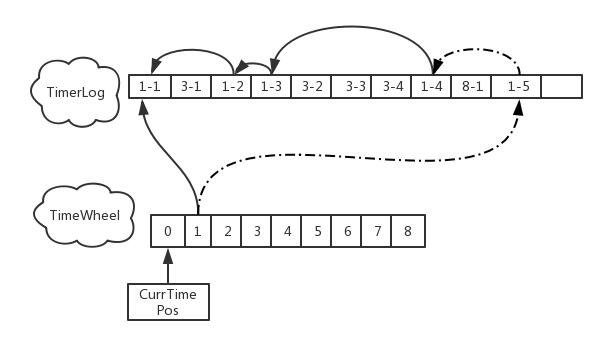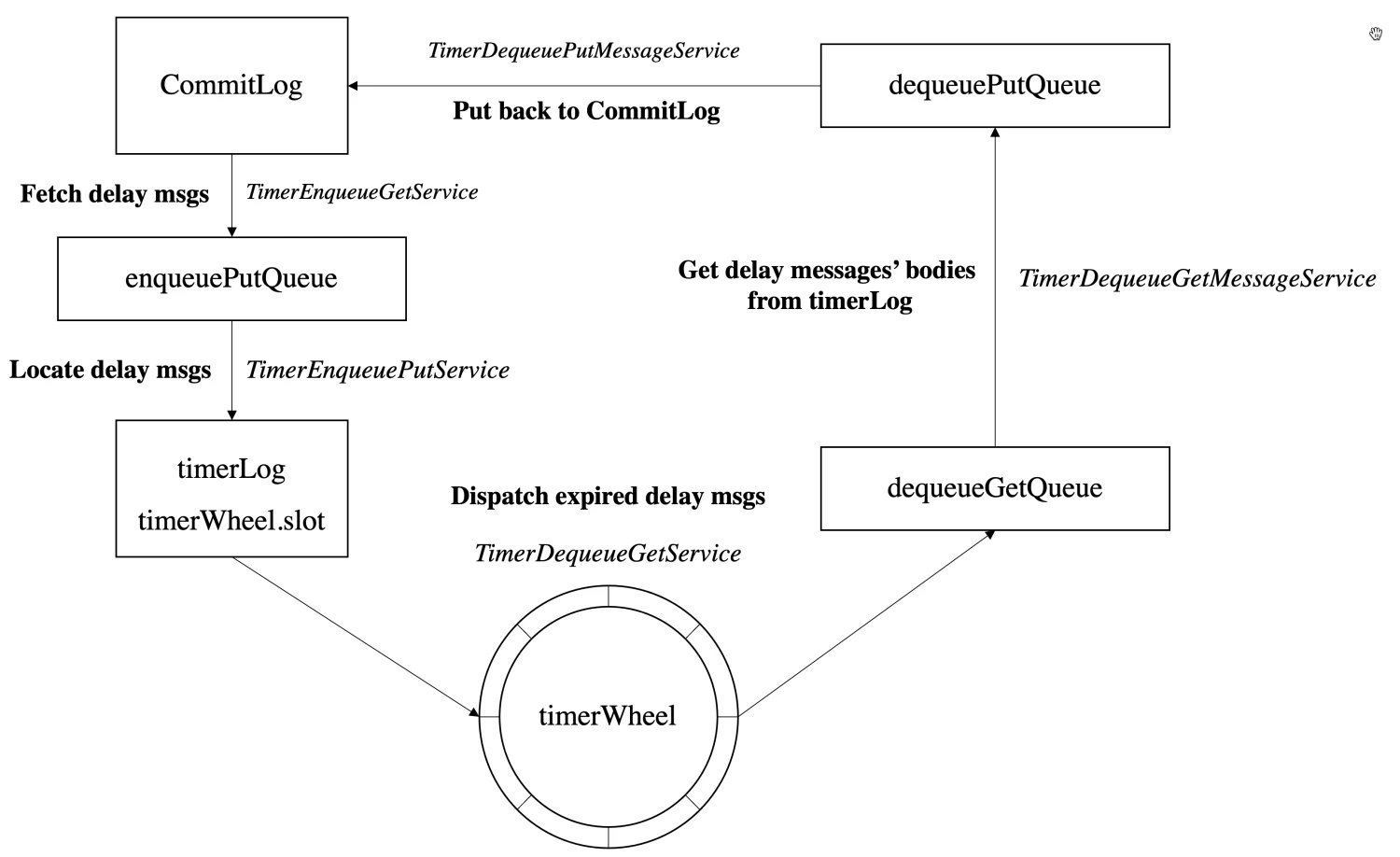RocketMQ 5.x任意延时消息源码分析
这里是小奏,觉得文章不错可以关注公众号小奏技术,文章首发。拒绝营销号,拒绝标题党
RocketMQ版本
- 5.1.0
背景
之前我们分析了RocketMQ 5.x固定等级延时消息源码分析
今天来分析RocketMQ 5.x新增的任意时间的延时消息
使用
固定延时消息
早期在4.x的时候RocketMQ只支持18个固定延迟时间的延时消息
使用方式如下
DefaultMQProducer producer = new DefaultMQProducer(producerGroup);
producer.setNamesrvAddr(namesrvAddr);
try {
producer.start();
} catch (MQClientException e) {
throw new RuntimeException(e);
}
Message msg = new Message(TOPIC /* Topic */,
TAG /* Tag */,
("Hello RocketMQ " + i).getBytes(RemotingHelper.DEFAULT_CHARSET) /* Message body */
);
// 设置延迟level为5,对应延迟1分钟
msg.setDelayTimeLevel(5);
producer.send(msg);
任意时间延时消息
支持延时消息时间限制
在5.x后支持了任意时间的延时消息,但是默认只支持3天
private int timerMaxDelaySec = 3600 * 24 * 3;
如果需要支持更长时间的延时消息,我们需要在broker的config中进行配置
timerMaxDelaySec = 3600 * 24 * 7
使用方式
DefaultMQProducer producer = new DefaultMQProducer(producerGroup);
producer.setNamesrvAddr(namesrvAddr);
try {
producer.start();
} catch (MQClientException e) {
throw new RuntimeException(e);
}
Message msg = new Message(TOPIC /* Topic */,
TAG /* Tag */,
("Hello RocketMQ " + i).getBytes(RemotingHelper.DEFAULT_CHARSET) /* Message body */
);
// 设置消息延迟投递时间为 10 秒后
msg.setDelayTimeMs(10000);
producer.send(msg);
当然我们也可以通过setDeliverTimeMs设置绝对时间进行投递,比如
DefaultMQProducer producer = new DefaultMQProducer(producerGroup);
producer.setNamesrvAddr(namesrvAddr);
try {
producer.start();
} catch (MQClientException e) {
throw new RuntimeException(e);
}
Message msg = new Message(TOPIC /* Topic */,
TAG /* Tag */,
("Hello RocketMQ " + i).getBytes(RemotingHelper.DEFAULT_CHARSET) /* Message body */
);
// 设置消息在指定的时间戳投递,例如 10 分钟后的某个时间点
long deliverTime = System.currentTimeMillis() + 10 * 60 * 1000;
message.setDeliverTimeMs(deliverTime);
producer.send(msg);
为什么4.x一直不支持任意时间的延时消息
主要是实现上有一定难度
目前RocketMQ的消息统一存储在commitLog,默认超过3天就会过期清理
如果是任意延时消息存储在commitLog如何保证消息不被清理,如果不存储在commitLog中如何存储
设计目标
- 支持任意时延的延迟消息
- 提供延迟消息可靠的存储方式
- 保证延迟消息具有可靠的收发性能
- 提供延迟消息的可观测性排查能力
设计思路
- 采用本地文件系统作为可靠的延时消息存储介质。延时消息另存TimerLog文件中。通过时间轮对定时消息进行定位以及存取
- 为延时消息设计新pipeline,定时扫描时间轮中的到时消息,转发至commitLog中
- 针对长时间定时消息,通过消息滚动的方式避免过大的消息存储量
- 定时消息查询,直接定位时间轮的slot进行查询;转为普通消息时,和当前的查询逻辑一致;
详细实现
存储
引入两个新的存储文件
- TimerLog: 主要用来存储演示消息的索引
- TimerWheel: 时间轮的主要实现

TimerWheel
TimerWheel是时间轮的实现。一些核心属性我们来看看
// 定义特殊标记:BLANK代表空,IGNORE代表在修改时忽略该字段
public static final int BLANK = -1, IGNORE = -2;
// 时间轮中的基础槽位数量 默认是 7 * 24 * 3600
public final int slotsTotal;
// 每个槽位代表的时间精度,单位为毫秒
public final int precisionMs;
// 整个时间轮文件在磁盘上的总长度(字节)
private final int wheelLength;
这个是整个时间轮的结构,然后时间轮中的基本存储单位为Slot,Slot的数据结构如下
/**
* Represents a slot of timing wheel. Format:
* ┌────────────┬───────────┬───────────┬───────────┬───────────┐
* │delayed time│ first pos │ last pos │ num │ magic │
* ├────────────┼───────────┼───────────┼───────────┼───────────┤
* │ 8bytes │ 8bytes │ 8bytes │ 4bytes │ 4bytes │
* └────────────┴───────────┴───────────┴───────────┴───────────┘
*/
- delayed_time:延迟时间
- first_pos:TimerLog 中该时刻定时消息链表的第一个消息的物理偏移量
- last_pos:TimerLog 中该时刻定时消息链表的最后(最新)一个消息的物理偏移量(链表头)
- num 消息条数
细节
虽然时间轮的基础槽位是7天
但是时间轮轮转的是2天的
TimerLog
TimerLog的存储方式也顺序写入Append-only Log
保留的不是真实的消息,只保留CommitLog的基本索引信息
详细的结构如下
| 名称 | 大小 | 备注 |
|---|---|---|
| size | 4B | 保存记录的大小 |
| prev_pos | 8B | 前一条记录的位置 |
| next_Pos | 8B | 后一条记录的位置,暂时为-1,作为保留字段 |
| magic | 4B | 魔数 |
| delayed_time | 4B | 该条记录的定时时间 |
| offset_real | 8B | 该条消息在commitLog中的位置 |
| size_real | 4B | 该条消息在commitLog中的大小 |
| hash_topic | 4B | 该条消息topic的hash code |
| varbody | 4B | 存储可变的body,暂时没有为空 |
新的pipeline实现

时间轮的处理主要分几个service
public void initService() {
enqueueGetService = new TimerEnqueueGetService();
enqueuePutService = new TimerEnqueuePutService();
dequeueWarmService = new TimerDequeueWarmService();
dequeueGetService = new TimerDequeueGetService();
timerFlushService = new TimerFlushService();
int getThreadNum = Math.max(storeConfig.getTimerGetMessageThreadNum(), 1);
dequeueGetMessageServices = new TimerDequeueGetMessageService[getThreadNum];
for (int i = 0; i < dequeueGetMessageServices.length; i++) {
dequeueGetMessageServices[i] = new TimerDequeueGetMessageService();
}
int putThreadNum = Math.max(storeConfig.getTimerPutMessageThreadNum(), 1);
dequeuePutMessageServices = new TimerDequeuePutMessageService[putThreadNum];
for (int i = 0; i < dequeuePutMessageServices.length; i++) {
dequeuePutMessageServices[i] = new TimerDequeuePutMessageService();
}
}
下面我们来详细介绍这些service是干嘛用的
TimerEnqueueGetService 扫描定时消息
TimerEnqueueGetService通过遍历消费队列索引的方式不断扫描定时消息 Topic(rmq_sys_wheel_timer) 中新的定时消息。
扫描到了之后将消息从CommitLog 中查出来,封装成TimerRequest,放入有界阻塞队列enqueuePutQueue(DisruptorBlockingQueue)。如果队列满,则会无限次重试等待,达到流控效果
public static final String TIMER_TOPIC = TopicValidator.SYSTEM_TOPIC_PREFIX + "wheel_timer";
enqueuePutQueue = new DisruptorBlockingQueue<>(DEFAULT_CAPACITY);
// 省略部分代码
public boolean enqueue(int queueId) {
ConsumeQueueInterface cq = this.messageStore.getConsumeQueue(TIMER_TOPIC, queueId);
long offset = currQueueOffset;
ReferredIterator<CqUnit> iterator = null;
iterator = cq.iterateFrom(offset);
if (null == iterator) {
return false;
}
int i = 0;
while (iterator.hasNext()) {
i++;
CqUnit cqUnit = iterator.next();
long offsetPy = cqUnit.getPos();
int sizePy = cqUnit.getSize();
cqUnit.getTagsCode(); //tags code
MessageExt msgExt = getMessageByCommitOffset(offsetPy, sizePy);
lastEnqueueButExpiredTime = System.currentTimeMillis();
lastEnqueueButExpiredStoreTime = msgExt.getStoreTimestamp();
long delayedTime = Long.parseLong(msgExt.getProperty(TIMER_OUT_MS));
// use CQ offset, not offset in Message
msgExt.setQueueOffset(offset + i);
TimerRequest timerRequest = new TimerRequest(offsetPy, sizePy, delayedTime, System.currentTimeMillis(), MAGIC_DEFAULT, msgExt);
// System.out.printf("build enqueue request, %s%n", timerRequest);
while (!enqueuePutQueue.offer(timerRequest, 3, TimeUnit.SECONDS)) {
if (!isRunningEnqueue()) {
return false;
}
}
currQueueOffset = offset + i;
}
currQueueOffset = offset + i;
return i > 0;
}
TimerEnqueuePutService 将定时消息放入时间轮和 TimerLog
TimerEnqueuePutService不断扫描队列enqueuePutQueue,然后取出TimerEnqueueGetService放入的TimerRequest- 取出的
TimerRequest请求中如果延时消息到期到期了则直接放入dequeuePutQueue准备投递到CommitLog - 如果延时消息没到期则存储到到
TimerLog和TimerWheel
执行逻辑核心代码
protected void fetchAndPutTimerRequest() throws Exception {
long tmpCommitQueueOffset = currQueueOffset;
// 消费enqueuePutQueue获取TimerRequest
List<TimerRequest> trs = this.fetchTimerRequests();
if (CollectionUtils.isEmpty(trs)) {
commitQueueOffset = tmpCommitQueueOffset;
//尝试推进写入时间(currWriteTimeMs),用于清理过期槽位或触发后续任务
maybeMoveWriteTime();
return;
}
// 循环尝试将这批消息放入时间轮,直到全部成功
while (!isStopped()) {
CountDownLatch latch = new CountDownLatch(trs.size());
for (TimerRequest req : trs) {
req.setLatch(latch);
// 将单个定时消息请求放入时间轮(Timer Wheel)
// 如果延时消息小于当前写入时间,则直接放入dequeuePutQueue队列
this.putMessageToTimerWheel(req);
}
//等待所有消息完成入轮(最多等待一段时间,内部有重试机制)
checkDequeueLatch(latch, -1);
boolean allSuccess = trs.stream().allMatch(TimerRequest::isSucc);
if (allSuccess) {
break;
} else {
holdMomentForUnknownError();
}
}
// 所有消息成功入轮后,更新已提交的队列位点(持久化消费进度)
// 更新为最后一条消息的 offset,表示这批消息已成功处理
commitQueueOffset = trs.get(trs.size() - 1).getMsg().getQueueOffset();
// 尝试推进写入时间(currWriteTimeMs)
maybeMoveWriteTime();
}
// 省略监控代码
protected void putMessageToTimerWheel(TimerRequest req) {
try {
// 当前消息的延迟时间已过期(小于当前写入时间)
if (shouldRunningDequeue && req.getDelayTime() < currWriteTimeMs) {
// 消息已过期,不应再入时间轮,而是直接转入出队队列(dequeuePutQueue)
req.setEnqueueTime(Long.MAX_VALUE);
dequeuePutQueue.put(req);
} else {
// 正常入轮:将消息存储到TimerLog和TimerWheel中
boolean doEnqueueRes = doEnqueue(
req.getOffsetPy(), req.getSizePy(), req.getDelayTime(), req.getMsg());
req.idempotentRelease(doEnqueueRes || storeConfig.isTimerSkipUnknownError());
}
perfCounterTicks.endTick(ENQUEUE_PUT);
} catch (Throwable t) {
LOGGER.error("Unknown error", t);
if (storeConfig.isTimerSkipUnknownError()) {
req.idempotentRelease(true);
} else {
holdMomentForUnknownError();
}
}
}
TimerDequeueWarmService
目前看代码这个线程好像没啥用
TimerDequeueGetService 扫描时间轮中到期的消息
TimerDequeueGetService主要是定时扫描TimerLog和TimerWheel,然后将任务放入dequeueGetQueue,推进时间轮
这个线程的作用是:推进时间轮,将时间轮槽位对应的定时消息请求从时间轮和 TimerLog 中取出,加入到 dequeueGetQueue 中。
每 0.1s 执行一次,根据当前扫描时间轮的时间戳,从时间轮和 TimerLog 中查询出 TimerRequest,并分成定时请求和定时消息取消请求两类。
先批量将取消请求入队,等待处理完毕,再将定时消息请求入队,等待处理完毕。
该槽位的定时消息都处理完成后,推进时间轮扫描时间到下一槽位
TimerFlushService
这个线程主要是将时间轮中的数据定时从pageCache中刷新到磁盘中
@Override
public void run() {
while (!this.isStopped()) {
try {
prepareTimerCheckPoint();
timerLog.getMappedFileQueue().flush(0);
timerWheel.flush();
timerCheckpoint.flush();
waitForRunning(storeConfig.getTimerFlushIntervalMs());
} catch (Throwable e) {
TimerMessageStore.LOGGER.error("Error occurred in " + getServiceName(), e);
}
}
TimerMessageStore.LOGGER.info(this.getServiceName() + " service end");
}
}
TimerDequeueGetMessageService 查询原始消息
TimerDequeueGetMessageService主要是消费dequeueGetQueue中的TimerRequest
获取到TimerRequest根据索引去CommitLog查询出原始消息,放入dequeuePutQueue中
从 dequeueGetQueue 中取出 TimerRequest
对取出的 TimerRequst,从 CommitLog 中查询原始消息
处理定时消息取消请求,查询出原始消息中要取消消息的 UNIQ_KEY,放入 deleteUniqKeys Set
处理普通定时消息请求
如果 DeleteUniqKeys 中包含这个消息,则什么都不做(取消投递)
否则将查出的原始消息放入 TimerRequest,然后将 TimerRequest 放入 dequeuePutQueue,准备投递到 CommitLog
- TimerDequeuePutMessageService 投递定时消息
这个线程的作用是:将消息从dequeuePutQueue 中取出,若已经到期,投递到 CommitLog 中
无限循环从 dequeuePutQueue 中取出 TimerRequest
将原始消息的 Topic 和 queueId 从消息属性中取出,用它们构造成一个新的消息
将消息投递到 CommitLog
如果投递失败,则需要等待{精确度 / 2}时间然后重新投递,必须保证消息投递成功